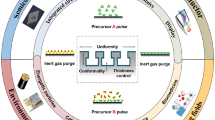Abstract
Mechanisms of microscale wear in silicon-based microelectromechanical systems (MEMS) are elucidated by studying a polysilicon nanotractor, a device specifically designed to conduct friction and wear tests under controlled conditions. Photoelectron emission microscopy (PEEM) was combined with near-edge X-ray absorption fine structure (NEXAFS) spectroscopy and atomic force microscopy (AFM) to quantitatively probe chemical changes and structural modification, respectively, in the wear track of the nanotractor. The ability of PEEM–NEXAFS to spatially map chemical variations in the near-surface region of samples at high lateral spatial resolution is unparalleled and therefore ideally suited for this study. The results show that it is possible to detect microscopic chemical changes using PEEM–NEXAFS, specifically, oxidation at the sliding interface of a MEMS device. We observe that wear induces oxidation of the polysilicon at the immediate contact interface, and the spectra are consistent with those from amorphous SiO2. The oxidation is correlated with gouging and debris build-up in the wear track, as measured by AFM and scanning electron microscopy (SEM).




Similar content being viewed by others
References
Maluf, N.: An introduction to microelectromechanical systems engineering. Meas. Sci. Technol. 13, 229 (2002)
Romig Jr., A.D., Dugger, M.T., McWhorter, P.J.: Materials issues in microelectromechanical devices: science, engineering, manufacturability and reliability. Acta Mater. 51, 5837 (2003)
de Boer, M.P., Mayer, T.M.: Tribology of MEMS. MRS Bull. 26, 302 (2001)
Mehregany, M., Gabriel, K.J., Trimmer, W.S.N.: Integrated fabrication of polysilicon mechanisms. IEEE Trans. Electron. Dev. 35, 719 (1988)
Yu-Chong, T., Muller, R.S.: IC-processed electrostatic synchronous micromotors. Sens. Actuators 20, 49 (1989)
Lim, M.G., Chang, J.C., Schultz, D.P., Howe, R.T., White, R.M.: Polysilicon microstructures to characterize static friction. In: Proceedings of IEEE Micro Electro Mechanical Systems: An Investigation of Micro Structures, Sensors, Actuators, Machines, pp. 82–88 (1990)
Beerschwinger, U., et al.: A study of wear on MEMS contact morphologies. J. Micromech. Microeng. 4, 95 (1994)
Sniegowski, J.J., Garcia, E.J.: Surface-micromachined gear trains driven by an on-chip electrostatic microengine. IEEE Electron Device Lett. 17, 366 (1996)
Hall, A.C., et al.: Sidewall morphology of electroformed LIGA parts-implications for friction, adhesion, and wear control. J. Microelectromech. Syst. 14, 326 (2005)
Alsem, D.H., et al.: Micron-scale friction and sliding wear of polycrystalline silicon thin structural films in ambient air. J. Microelectromech. Syst. 17, 1144 (2008)
de Boer, M.P., et al.: High-performance surface-micromachined inchworm actuator. J. Microelectromech. Syst. 13, 63 (2004)
Luck, D.L., de Boer, M.P., Ashurst, W.R. Baker, M.S.: Evidence for pre-sliding tangential deflections in MEMS friction. In: TRANSDUCERS ’03. 12th International Conference on Solid-State Sensors, Actuators and Microsystems. Digest of Technical Papers (Cat. No.03TH8664), vol. 1, pp. 404–407 (2003)
Corwin, A.D., De Boer, M.P.: Effect of adhesion on dynamic and static friction in surface micromachining. Appl. Phys. Lett. 84, 2451 (2004)
Flater, E.E., et al.: In situ wear studies of surface micromachined interfaces subject to controlled loading. Wear 260, 580 (2006)
Hankins, M.G., Resnick, P.J., Clews, P.J., Mayer, T.M., Wheeler, D.R., Tanner, D.M., Plass, R.A.: Vapor deposition of amino-functionalized self-assembled monolayers on MEMS. In: Proceedings of SPIE—The International Society for Optical Engineering, vol. 4980, pp. 238–247 (2003)
Subhash, G., Corwin, A.D., Deboer, M.P.: Operational wear and friction in MEMS devices. American Society of Mechanical Engineers, Micro-Electro Mechanical Systems Division, MEMS, pp. 207–209 (2004)
Tsai, H.M., et al.: Enhancement of Si–O hybridization in low-temperature grown ultraviolet photo-oxidized SiO2 film observed by X-ray absorption and photoemission spectroscopy. J. Appl. Phys. 103, 013704 (2008)
Orignac, X., Vasconcelos, H.C., Almeida, R.M.: Structural study of SiO2–TiO2 sol–gel films by X-ray absorption and photoemission spectroscopies. J. Non-Cryst. Solids 217, 155 (1997)
Grierson, D.S., et al.: Tribochemistry and material transfer for the ultrananocrystalline diamond-silicon nitride interface revealed by X-ray photoelectron emission spectromicroscopy. J. Vac. Sci. Technol. B 25, 1700 (2007)
Gilbert, B., et al.: X-ray absorption spectroscopy of silicates for in situ, sub-micrometer mineral identification. Am. Mineral. 88, 763 (2003)
Patton, S.T., Zabinski, J.S.: Failure mechanisms of a MEMS actuator in very high vacuum. Tribol. Int. 35, 373 (2002)
Walraven, J.A., Headley, T.J., Campbell, A.N., Tanner, D.M.: Failure analysis of worn surface micromachined microengines. In: Proceedings of the SPIE—The International Society for Optical Engineering, vol. 3880, pp. 30–39 (1999)
Alsem, D.H., et al.: An electron microscopy study of wear in polysilicon microelectromechanical systems in ambient air. Thin Solid Films 515, 3259 (2007)
Acknowledgments
This study was partly funded by Air Force grant FA9550-08-1-0024, and partly by Sandia—a multiprogram laboratory operated by Sandia Corporation, a Lockheed Martin Company, for the United States Department of Energy’s National Nuclear Security Administration under contract DE-AC04-94AL85000. The authors thank Dr. Scholl and Dr. Doran for their help with PEEM II at the Advanced Light Source (ALS). The ALS and use of the Center for Nanoscale Materials facility are supported by the DOE under Contract DE-AC02-05CH11231 and Contract DE-AC02-06CH11357, respectively.
Author information
Authors and Affiliations
Corresponding author
Rights and permissions
About this article
Cite this article
Grierson, D.S., Konicek, A.R., Wabiszewski, G.E. et al. Characterization of Microscale Wear in a Polysilicon-Based MEMS Device Using AFM and PEEM–NEXAFS Spectromicroscopy. Tribol Lett 36, 233–238 (2009). https://doi.org/10.1007/s11249-009-9478-7
Received:
Accepted:
Published:
Issue Date:
DOI: https://doi.org/10.1007/s11249-009-9478-7




